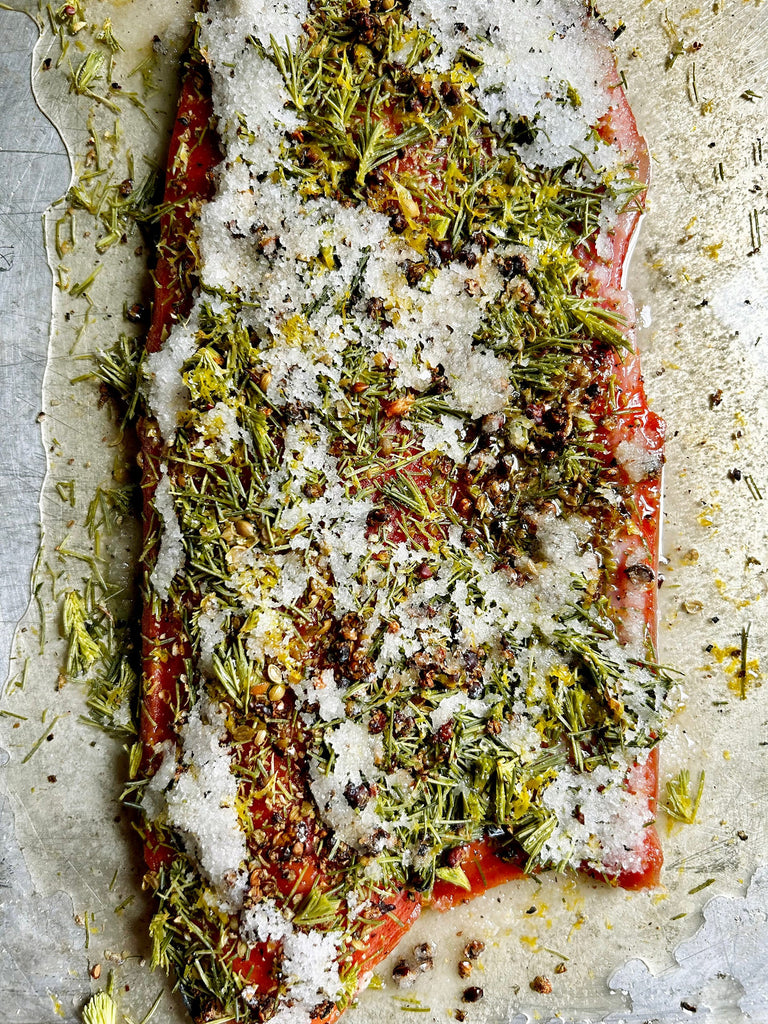Recipe created by melina Hammer
I recognize that access to spruce tips and juniper berries is season-specific, though the latter can be found at lots of health food stores and specialty markets these days. I’d frozen some of my spring stash of spruce tips precisely for this purpose, knowing I would want to cure some pieces when time allowed. If you do not have spruce tips, use the finely grated zest from two oranges, and for extra flavor add dill, similar to my recipe for gravlax in the CatBird Cottage Recipe Book p. 94.
*Be sure to use a fillet that has been previously frozen, to account for parasites commonly found in salmon
Ingredients:
1 side sockeye salmon (you could also use coho or king salmon and make 1.5 or 2 times the cure recipe to offset the larger portion)
1 cup kosher salt (I use Diamond Crystal)
1 tbsp coarsely ground black pepper
1/2 cup cane sugar
1 tbsp juniper berries, finely chopped
1 cup spruce tips, chopped
1 tbsp coriander seeds, toasted and ground in a mortar and pestle
finely grated zest from 1 lemon
To Prepare:
Stir together the salt, sugar, and pepper in a medium bowl until well combined.
Sprinkle a layer of the salt mixture in a shape similar to the salmon in the center of a sheet pan, creating a uniform surface to lay the fish onto.
Scatter the chopped spruce tips, followed by the coriander seeds, then the juniper berries, across the whole surface of the fish. Add the finely grated lemon zest, then sprinkle another layer of the salt mixture to entirely coat the salmon, edge-to-edge.
Keeping it level, tightly wrap the sheet pan in saran wrap and refrigerate. After a day-and-a-half the mixture will resemble a loose liquid in parts, surrounding the fish. This is totally normal.
Use your hands to thoroughly wipe the cure off the fish, or lightly rinse the fish and then pat it dry. I like leaving some of the aromatics clinging to the salmon, so that a morsel here and there includes a small burst of that flavor. Conversely, you also do not want the fish too salty, which if you don’t wipe the cure ingredients away enough, is the other risk. Make a small slice, knife as shallow to the surface of the fish as possible, taste, and see. Either rinse-pat again, or leave it be. Final note, keep in mind the thinly sliced ribbons will be added to mild foods such as eggs, rice, pasta, toast, etc, so the cured salmon’s saltiness is part of the draw. The more you experiment with new cure recipes, the more you will develop your own process.

Thinly slice the fish on a very shallow angle - as close to horizontal as possible - for see-through ribbon slices. Store any unused cured salmon in a sealed container the refrigerator for up to 5 days, or wrap in parchment, tightly seal in a resealable plastic bag, and freeze for up to 2 months.
← Back to Recipes